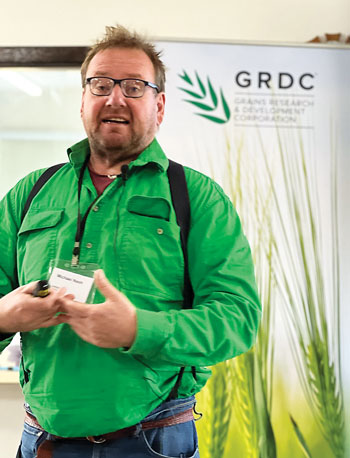Slugs are a unique pest to manage. Unlike insects, slugs do not have a set life cycle and instead are
opportunistic, breeding when conditions are favourable. They are also hermaphrodites, meaning that both mating individuals can produce eggs.
Dr Michael Nash, from La Trobe University/University of Adelaide, says that while dry spring conditions might have reduced slug breeding in 2023, slugs can live for two years so they are likely to still pose a risk in 2024.
This is further exacerbated by the specific biology of certain species determining exactly when they are active, what time they breed, and the best time to bait.
“Proactive management strategies yield the best results and return on investment,” Dr Nash says. “Long-term monitoring of slugs in spring is vital to providing information on population dynamics.”
Dr Nash spoke at GRDC Updates earlier this year.
Lessons from 2022 and 2023

Dr Michael Nash. Photo: GRDC
Dr Nash says that the following lessons are what allowed for successful slug management in 2023.
- High soil moisture is the main predictor of high slug activity.
- Wet winters extending into cool springs in combination with bulky crops are ideal conditions for breeding.
- Proactive management strategies give the best results and return on investment.
- Long-lasting slug and snail bait that is resistant to rainfall, attractive, palatable and capable of spreading uniformly has been found to be effective at protecting establishing crops.
Dr Nash says that bait rate was the most crucial factor in 2023 for successful crop establishment, ensuring that enough metaldehyde was applied to meet the large numbers of slugs.
However, it is also important to include baiting in an integrated approach, such as rolling after sowing and before first application of bait.
“In 2023, there were examples of baits being eaten within two to three days of being applied at label rate, so it is important to monitor closely that there are enough baits out protecting your crops.”
Growers who did not have baits ordered ahead of the season often struggled to source them within the crucial time period, yielding poor slug control.
“That’s why you need some bait in stock – because if you wait a week, especially on crops that are slow to establish, that’s too long.”
What makes good bait?
Taste, distribution, consistent pellet size, weight and density are all important.
Slugs need to be actively searching for food, Dr Nash says. Bait needs to be “attractive enough to lure its target. Attractive pellets will cause slugs to alter their paths”.
Slugs also need to consume enough for a lethal dose, which can be impacted by palatability, having enough bait for the population and enough toxicant in the bait, says Dr Nash. It is also helpful to have bait that is resistant to rainfall.
Overall the best recipe for success is being proactive, monitoring early and often and using an integrated approach to slug management.
More information: Dr Michael Nash, whatbugsyou@gmail.com
Slugs In Crops: The Back Pocket Guide
Integrated approaches assessed
A GRDC-supported project to optimise slug management is also underway. Led by Dr Kate Muirhead from the University of Adelaide, it will investigate slug population dynamics in response to climate and crop environment.
The aim is to develop a model to assess management options such as paddock selection, crop choice, strategic cultivation, stubble burning, rolling after sowing, bait application and timing.
Slugs cost growers an average of $8.7 million annually and are the sixth most damaging invertebrate pest for the Australian grains industry.
Spending on baits continues to increase with average baiting costs of $30-$120 a hectare reported in high-rainfall zones.

























































